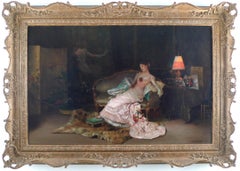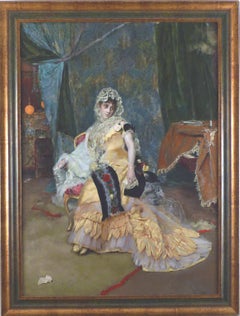Rogelio Egusquiza
1870s Symbolist Figurative Paintings
Canvas, Oil
1880s Realist Interior Paintings
Oil, Panel
People Also Browsed
20th Century French Art Deco Chandeliers and Pendants
Bronze
Early 20th Century European Art Nouveau Vases
Bronze
Early 20th Century French Art Deco Animal Sculptures
Brass
Vintage 1910s French Art Nouveau Glass
Glass
Antique 15th Century and Earlier German Decorative Art
Other
Early 20th Century Italian Art Deco Dining Room Tables
Rattan
Antique 19th Century Chinese Beds and Bed Frames
Gold Leaf
Antique Mid-19th Century Spanish Biedermeier Urns
Ceramic
Mid-20th Century Italian Neoclassical Side Tables
Wood
Antique 18th Century French Chinoiserie Table Mirrors
Mirror, Wood
Antique 17th Century Chinese Ming Center Tables
Elm
Antique 1730s Dutch Table Mirrors
Walnut
Antique Mid-19th Century British Louis XVI Center Tables
Ormolu
Antique 18th Century Chinese Chinese Chippendale Ceramics
Ceramic, Porcelain
Early 20th Century Art Deco Table Lamps
Vintage 1930s Chinese Art Deco Chinese and East Asian Rugs
Wool
Finding the Right Figurative-paintings for You
Figurative art, as opposed to abstract art, retains features from the observable world in its representational depictions of subject matter. Most commonly, figurative paintings reference and explore the human body, but they can also include landscapes, architecture, plants and animals — all portrayed with realism.
While the oldest figurative art dates back tens of thousands of years to cave wall paintings, figurative works made from observation became especially prominent in the early Renaissance. Artists like Michelangelo, Leonardo da Vinci and other Renaissance masters created naturalistic representations of their subjects.
Pablo Picasso is lauded for laying the foundation for modern figurative art in the 1920s. Although abstracted, this work held a strong connection to representing people and other subjects. Other famous figurative artists include Francis Bacon and Lucian Freud. Figurative art in the 20th century would span such diverse genres as Expressionism, Pop art and Surrealism.
Today, a number of figural artists — such as Sedrick Huckaby, Daisy Patton and Eileen Cooper — are making art that uses the human body as its subject.
Because figurative art represents subjects from the real world, natural colors are common in these paintings. A piece of figurative art can be an exciting starting point for setting a tone and creating a color palette in a room.
Browse an extensive collection of figurative paintings on 1stDibs.

